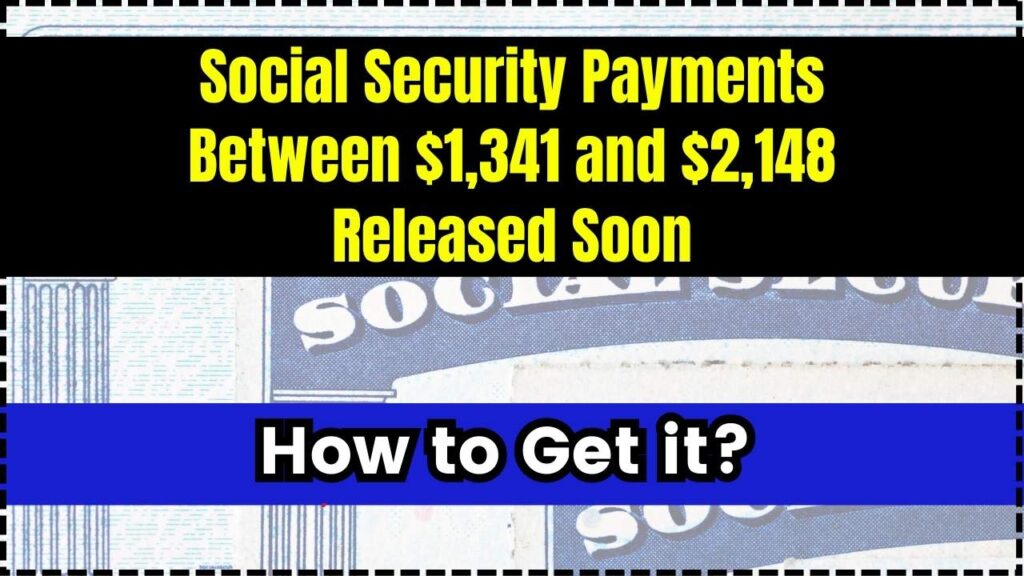Social Security Payments Between $1,341 and $2,148: In May 2025, Social Security payments between $1,341 and $2,148 are scheduled for release, and if you’re planning your retirement or already eligible, now’s the time to pay attention. These payments aren’t just for today’s seniors—they’re part of a system millions of Americans rely on, and understanding how it works is key to securing your financial future. Whether you’re planning to claim benefits for the first time or helping a loved one get started, this guide breaks down everything you need to know. We’ll cover eligibility, how much you can get, how to apply, how to avoid costly mistakes, and smart ways to increase your monthly check.
Social Security Payments Between $1,341 and $2,148
Navigating Social Security payments between $1,341 and $2,148 doesn’t have to be overwhelming. With the right tools and knowledge, you can make smart choices that secure your retirement income and give you peace of mind. Remember: it’s your money—you earned it, so claim it wisely. From knowing when to apply, to boosting your check by waiting until 70, every decision matters. The system might be complex, but with the resources in this guide, you’ve got the power to take control.

| Feature | Details |
|---|---|
| Payment Range | $1,341 (age 62) to $2,148 (age 70), average |
| Max Possible Benefit | $4,873/month in 2025 (for high earners retiring at age 70) |
| Eligibility | 62+ years old, with 40+ work credits |
| Payment Dates | Based on birthday; May 21, 2025, for late-month births |
| Application | Online, by phone, or in person |
| Official Website | Social Security Administration |
What Are These Payments and Why Do They Matter?
Social Security is a retirement program that provides monthly income based on the taxes you paid while working. If you’ve paid into the system through payroll taxes for at least 10 years, you’re likely eligible.
In May 2025, Social Security checks averaging $1,341 to $2,148 will be distributed. These figures vary depending on:
- Your earnings history
- The age you start collecting benefits
- Cost-of-living adjustments (COLA)
Eligibility: Who Can Get These Payments?
You qualify for Social Security retirement benefits if:
- You’re at least 62 years old
- You’ve earned at least 40 work credits (usually 10 years of work)
- You’ve paid Social Security taxes (FICA) through your job
Understanding Benefit Amounts
The amount you receive depends on three main factors:
1. Earnings History
The SSA calculates your benefit based on your highest 35 years of earnings.
2. When You Retire
The earlier you claim, the lower your monthly payment. Here’s a simplified table:
| Retirement Age | Monthly Benefit (Approximate) |
|---|---|
| 62 (earliest) | $1,341 |
| 67 (Full Retirement Age) | $1,907 |
| 70 (max delayed credits) | $2,148+ |
3. COLA Adjustments
Each year, benefits are adjusted for inflation. For example:
- 2023 COLA: 8.7% increase
- 2024 COLA: 3.2%
- 2025 COLA: TBD but expected to rise slightly due to inflation trends
How to Apply for Social Security Payments Between $1,341 and $2,148: Step-by-Step Guide
Step 1: Set Up Your “My Social Security” Account
Visit ssa.gov/myaccount to view your benefit estimate and earnings history.
Step 2: Prepare Required Documents
- Social Security Number
- Birth certificate
- W-2 or self-employment tax return
- Bank details for direct deposit
Step 3: Submit Your Application
You can apply:
- Online at ssa.gov/retire
- By phone at 1-800-772-1213
- In-person at a local SSA office
Step 4: Track Your Claim
Most applications are processed within 4 to 6 weeks.
When Will I Get Paid?
SSA pays benefits based on your birthday:
| Birth Date | Payment Day |
|---|---|
| 1st–10th | 2nd Wednesday |
| 11th–20th | 3rd Wednesday |
| 21st–31st | 4th Wednesday |
For May 2025, people born from the 21st–31st will be paid on May 21.
Real-Life Examples
John (Age 62): Retired early with modest income history. Receives $1,341/month.
Maria (Age 70): Waited to claim benefits and had a long, high-earning career. Receives $2,148/month—a 60% boost over John.
Cost-of-Living Adjustments (COLA): Why It Matters
COLA ensures your benefits keep up with inflation. Adjusted annually based on the Consumer Price Index (CPI-W), it protects retirees from rising costs of essentials like food, rent, and medication.
Avoid These Common Mistakes
- Claiming too early: You could lose up to 30% of your full benefits.
- Not checking your earnings record: Mistakes can reduce your payout.
- Forgetting spousal benefits: Married? You might be entitled to more.
- Assuming benefits aren’t taxable: Up to 85% of benefits can be taxed if your total income exceeds IRS thresholds.
State Taxes and Social Security
Most states do not tax Social Security benefits. But if you live in:
- Colorado
- Kansas
- Minnesota
- Missouri
- Montana
- Nebraska
- New Mexico
- Rhode Island
- Utah
- Vermont
…your benefits might be taxed. Check your state’s revenue website for details.
What About SSI?
If your income and assets are limited, you may qualify for Supplemental Security Income (SSI).
- 2025 max benefit: $967 (individual), $1,450 (couple)
- Eligibility: Low income, over 65, or disabled
What the Future Looks Like?
Social Security’s future is always a hot topic. According to the SSA’s 2024 report:
- Trust funds are projected to be depleted by 2033
- If no action is taken, benefits could be reduced to about 77%
Congress is debating reforms, but no cuts are expected for current beneficiaries.
Triple Social Security Payments Worth Up to $5,108 Coming in May 2025; See If You Qualify
$2,831 Social Security Checks Coming for 62-Year-Olds; If You Meet These 4 Key Rules
Where’s Your Social Security Check? First 2025 Payment Drops This Week; See the Full Schedule
Frequently Asked Questions (FAQs)
Q1. Can I work and still receive Social Security?
Yes, but if you’re under Full Retirement Age (67), your benefits may be reduced.
Q2. Are benefits taxed?
They can be. If you earn over $25,000 (single) or $32,000 (married), part of your benefits may be taxable.
Q3. Can I change my mind after applying?
Yes. You can withdraw your claim within 12 months and repay the benefits, then reapply later for a higher payout.
Q4. How is the payment sent?
Direct deposit is standard. You can also get a prepaid Direct Express card if you don’t have a bank account.






